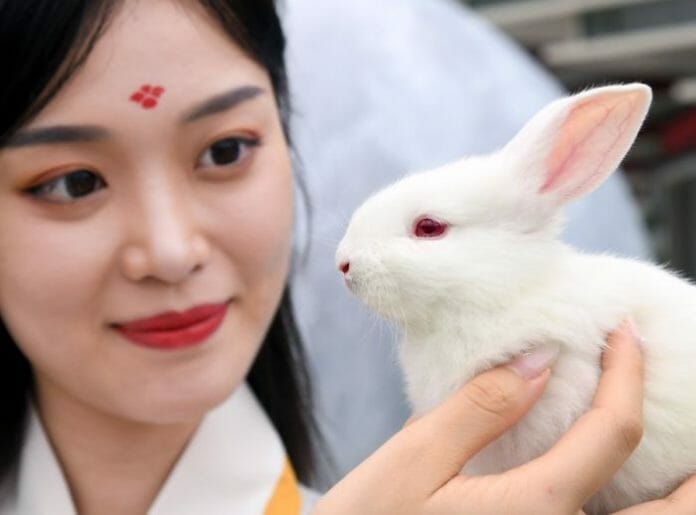Ushering into the year of the rabbit, a zodiac animal that has long resembled the astute, intelligent, and quick-thinking animal, there are 3 rabbit versions in China’s mythology that dates back centuries and are still revered today.
There are three significant bunnies steeped in the culture that is celebrated during this auspricous year.
Jade Rabbit
This is probably the most famous rabbit in China. It features on the special stamps issued by China Post to celebrate the Year of the Rabbit and was mentioned when President Xi extended his Lunar New Year greetings.
Known as Yutu, or Jade Rabbit, the pet of Lunar Goddess Chang’e often appears grinding herbal medicines with a pestle in the Lunar Palace.
Legend has it that Chang’e, after swallowing a magic pill, took her pet and flew toward the moon where she became a goddess, and she has lived there with the white jade rabbit ever since.
Archaeologists say that rabbits and toads have long been imagined as inhabitants of the moon in Chinese mythology, probably due to their resemblance to the dark spots on the lunar surface.
The relationship between rabbits and the moon had been established in the Western Han Dynasty (202 BC-25 AD), evidenced by unearthed silk paintings carrying images of running rabbits on the moon, said Ai Lulu, a researcher at the Chongqing China Three Gorges Museum.
As for images of rabbits crushing herbal medicines with a mortar and pestle, Ai suggests they may have derived from the story of another goddess Xiwangmu, or Queen Mother of the West, who has a retinue of rabbits making elixirs of immortality
The rabbit’s common association with Earth’s only natural satellite led China to name its first moon rover “Yutu.”
White Rabbit
The image of a white rabbit often leaves a sweet taste in the minds of Chinese children.
Born in 1959 in Shanghai, White Rabbit milk candies are a household name in China.
Milk powder is the main ingredient of the candy, giving it its iconic creamy taste and texture. In times of food shortages, White Rabbit candies were hailed as nutritional boosters and gifted to children during festivals.
The 64-year-old rabbit sweets have enjoyed renewed popularity among young consumers in recent years, with the roll-out of White Rabbit-flavored milk tea, ice cream, and even lip balm.
The candy’s bunny mascot has also been incorporated into the designs of global cosmetics brands and luxury houses, which have shown rising interest in China’s Zodiac animal culture.
Lord Rabbit
Lord Rabbit, known as Tu’er Ye in Chinese, is an auspicious clay toy for children in Beijing.
With a human body and a rabbit’s ears and mouth, Lord Rabbit is actually a deity governing health and medicine, and an alternate version of the jade rabbit.
The legend goes that Beijing once suffered a plague before the Mid-Autumn Festival. The goddess Chang’e dispatched the rabbit to cure the disease. In gratitude, Beijing people made clay figurines to pay homage to the plague dispeller.
The iconic image of Lord Rabbit depicts the creature as a general, wearing a golden helmet and armor, and riding a tiger.
Despite its military air and male title “ye,” meaning “lord,” some craftspeople argue the deified rabbit was actually a female doctor.
“She borrowed a helmet and armor from a deity in a temple, and dressed like a man to treat patients in the then feudal society,” said Shuang Yan, a Lord Rabbit craftsman.
.









